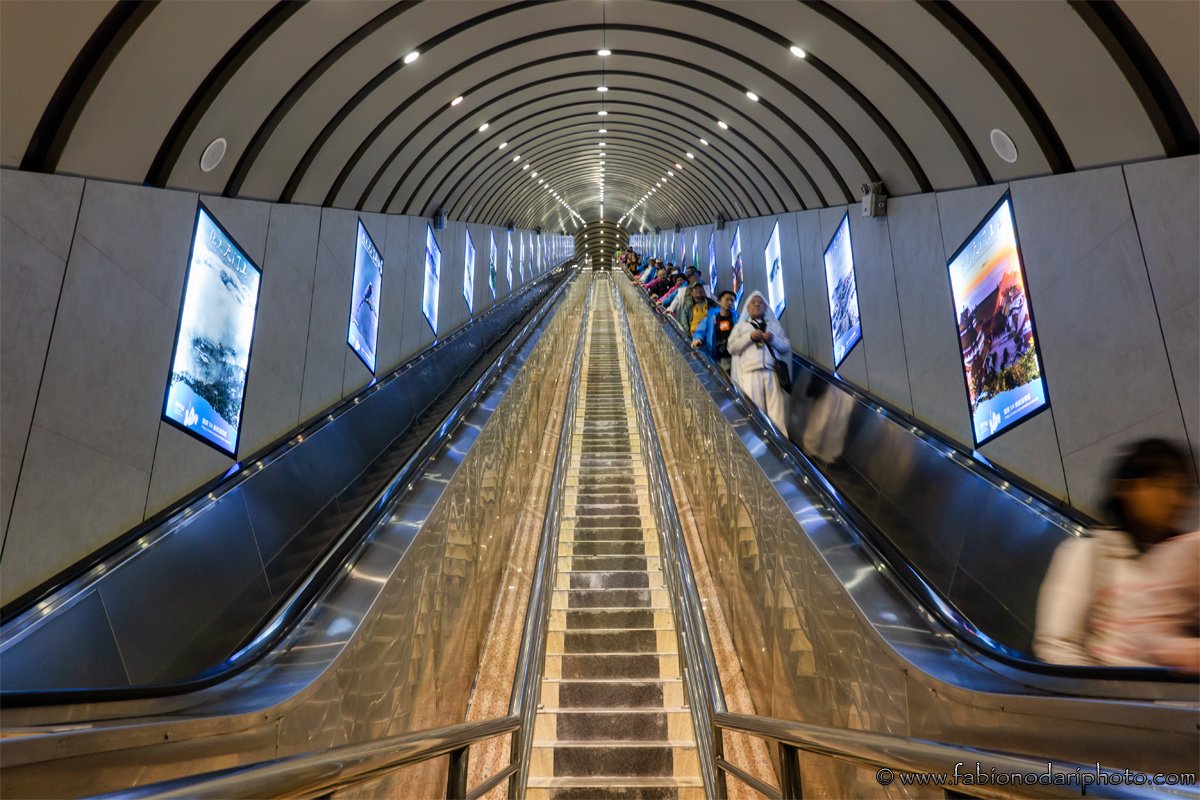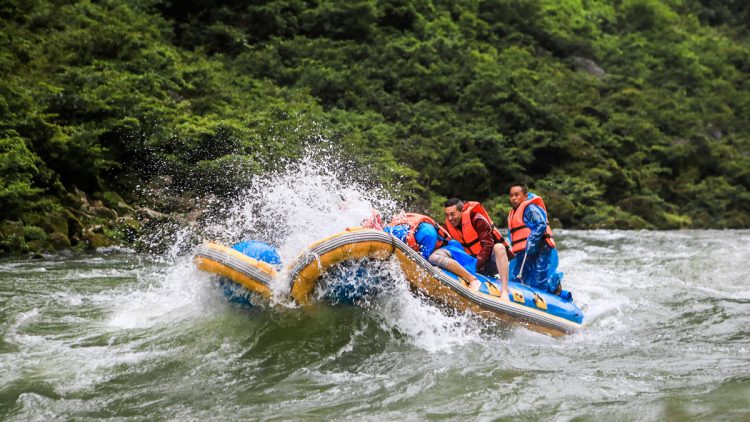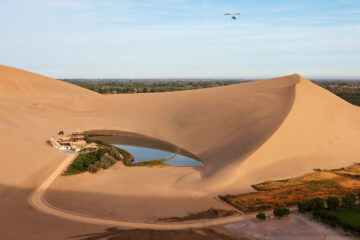Zhangjiajie (张家界) is probably the most spectacular scenic area in China. Find out some of the most interesting things to see and do in this beautiful place in Hunan province.

A few places in China are as iconic as the mountains of Zhangjiajie (张家界). Even if you are not familiar with the Chinese name, I’m sure you’ve seen Chinese paintings, including its misty peaks, or perhaps you have watched the movie Avatar with the floating mountains of Pandora, which were inspired by a sandstone formation in the park called Heavenly Pillar.
General info about Zhangjiajie
The first thing to realize when talking about Zhangjiajie is that the name can cause a lot of confusion since it can refer to different places, including:
- Zhangjiajie City (about 30 Km from the National Park)
- Zhangjiajie National Park (which includes several different destinations, such as the Wulingyuan Scenic Area)
- Zhangjiajie National Forest (for clarity, it’s the place with the Avatar mountains, even though I don’t like this expression since, in my opinion, it is much more than that and is part of the Wulingyuan Scenic Area).
Also, some names sound similar, such as Zhangjiajie, Yuanjiajie, and Yangjiajie, which adds to the confusion.
Another thing to keep in mind is that visiting the different parks can be quite expensive, as you’ll see. You can get to Zhangjiajie by flying there, by train (I recommend using Trip.com), or by bus. As you can imagine, this place is well connected with the rest of China.
How many days you should stay in Zhangjiajie? It depends on how much of the massive park you want to explore. In my opinion, the very least is 3 days/2 nights. If you have more time, you can explore more. The ticket for the Wulingyuan Scenic Area can be used for three consecutive days.
Wulingyuan Scenic Area

The Wulingyuan Scenic Area in Zhangjiajie was included in the Unesco World Heritage List in 1992. It is a quite big area that covers 690 square kilometres (266 square miles) and consists of four parts:
- Zhangjiajie National Forest Park
- Suoxi Valley Nature Reserve
- Tianzi Mountain Nature Reserve
- the newly added Yangjiajie Scenic Area.
You can get to the Wulingyuan Scenic Area by bus from the Zhangjiajie train station, which takes about 40 minutes. If you prefer private transportation, you can call a Didi driver, the Chinese version of Uber. Once you arrive at the park entrance, you must buy a ticket that costs about 260 RMB and can be used for three consecutive days from March to November and four consecutive days from December to February.
The ticket, however, DOES NOT include other things such as the Bailong elevator at the park’s entrance (72 RMB single trip), Yangjiajie cable car (76 RMB), and other buses/cable cars/elevators in the park. If you have the time to visit the whole area, you’ll spend a lot of money.
Zhangjiajie National Forest Park

In 1982 it was recognized as China’s first national forest park with an area of 4,810 ha. Zhangjiajie National Forest Park is part of the Wulingyuan Scenic Area. In 2004, Zhangjiajie Geopark was listed as a UNESCO global geopark. Zhangjiajie National Forest Park is divided into:
- Huangshizhai
- Jinbianxi
- Yuanjiajie
- Yangjiajie
- Tianzishan
- Suoxiyu
Tianzi Mountain Nature Reserve/Tianzi Shan (天子山)

It is probably the more spectacular part of the Wulingyuan Scenic Area. This is where you can often see the sandstone peaks partially hidden in fog and, if lucky, a sea of clouds. The highest peak of Tianzi Mountain is 1262.5 meters above sea level.
Yuanjiajie Scenic Area (袁家界)

Along with the Tianzi mountain, the Yuanjiajie Scenic Area is often referred to as the inspiration for the Avatar movie, thanks to its beautiful peaks covered with lush vegetation. Since April 2002, it’s been possible to access the area in merely 2 minutes thanks to the Bailong elevator.
It’s claimed to be the world’s highest and heaviest outdoor elevator. Before its opening, people had to hike for about 2 hours. It is one of the most spectacular places in the world.
Yangjiajie Scenic Area (杨家界)
Connected to the Yuanjiajie Scenic Area, Yangjiajie is located northwest of Zhangjiajie Forest Park and is home to some beautiful rock formations.
Suoxi Valley Nature Reserve/Suoxiyu (索溪峪)
Means “foggy mountain village” in the Tujia language (a local ethnic group ); the Suoxi Valley Nature Reserve is located in the northeast part of the Wulingyuan Scenic Area. These are the most famous spots:
Ten-mile Natural Gallery/Shili Hualang (十里画廊)

The Ten-mile natural gallery is a 5.8 Km long valley in the north-eastern part of the Wulingyuan Scenic Area. You can get there on buses No.7 or No.9. When you arrive in the area you can either walk or take the electric monorail. At the end of the valley, you’ll find some monkeys.
Yellow Dragon Cave/ Huanglong Dong (黄龙洞)

Yellow Dragon Cave is 7.5 kilometers long and 140 meters deep and is the largest karst cave in China. There is an underground river (not as beautiful as the Underground River in Palawan, though), several ponds, and tons of stalagmites and stalactites carefully illuminated with disco lights, as it happens in every touristic cave in China.
Honestly, in my opinion, it’s not worth a visit. Jiuxiang caves in Yunnan are much better. Also, you’ll find lots of tourists, and there isn’t much nature left inside the cave. If you want to go, you can take bus No.3 at Wulingyuan Bus Station or the Wulingyuan Scenic Area, and get out at Yellow Dragon Cave (黄龙洞), then walk for about 20 mins.
The Zhangjiajie Glass Bridge (张家界大峡谷玻璃桥) and Grand Canyon (张家界大峡谷)

The Glass Bridge is another very iconic landmark of Zhangjiajie and, for this reason, is extremely popular. I think it was rather disappointing, and even though the location is quite spectacular, I don’t see the need to ruin a natural place like Zhangjiajie with more man-made structures. Anyway, if you are into architecture you might want to check it out.
For some weird reason, DSLR cameras are not allowed on the bridge. We got special permission thanks to the fact that the local tourism board and Ctrip organized the trip.
The Grand Canyon is an entirely different thing, and it’s simply stunning.



It is not very crowded because there are no elevators (for now) and no buses but only a beautiful wooden path that will take you through the canyon. It reminded me of Vintgar Gorge in Slovenia, but this valley is more spectacular.
After the disappointing Glass Bridge, I wasn’t expecting anything cool, but I was wrong. The canyon was amazing.
Tianmen Mountain (天门山)

Located about 10 kilometers south of Zhangjiajie City, Tianmen Mountain (天门山) is accessible by cable car or by bus. The view from the top of the mountain is fantastic, and if you are afraid of heights, you might have some problems. The mountain has an elevation of 1518 meters.

Glass bridges and wooden paths connect the other peaks in the area, and it takes at least half a day to explore the main areas. You can use the elevators if you feel lazy and don’t want to walk up (or down) to the Tiananmen Gate.

There are about 30 of them for a total length of 897 meters in what must be one of the world’s longest escalator systems.
Other things to do in Zhangjiajie
Xiangxi Grand Theatre (湘西大剧院)

If you have some spare time in Zhangjiajie, you should attend the Charming Xiangxi Show at the Xiangxi Grand Theatre. Several performances during the show mainly focus on the Tujia, Bai, and Miao minorities and their daily life. The show is divided into two parts: the first one is indoor, and the second one is outdoor. You can skip the second part, which is nothing but a sale pitch.
Rafting in the Maoyan River (茅岩河)

Probably due to the distance from Zhangjiajie (about two hours), the Maoyan River doesn’t seem to be very popular right now, however it’s very spectacular.
While exploring the river from the boat, you can see the beautiful mountains around the river and some local people on their tiny boats as they travel back and forth from their remote houses to the nearby villages.
It was a refreshing experience, without any tourists and surrounded by nature. If you have the time, it’s worth a visit.


Best time to visit Zhangjiajie and where to stay

As you can see from the pictures, this part of China is incredibly beautiful and green, but it also rains a lot. I was particularly unlucky with the weather during my trip. The rain is not a problem, nor are the clouds, which give the scenic area the perfect mood. The problem is that sometimes it’s completely foggy, and you won’t be able to see anything: that’s exactly what happened to me. My suggestion is to visit Zhangjiajie during Spring or Fall.
The best time would probably be between November and April: fewer chances of rain, though the temperature is a bit low (around 8°C). I read that April is the best month. I can’t confirm it from personal experience, but it makes sense.
Please avoid the national holidays at all costs! Zhangjiajie is crowded all year round, but I can’t imagine what it will be like in the first week of May or October. A friend told me you can expect to queue for 2 hours only to get into the Bailong elevator.
For accommodation, you have two main options: you can choose a hotel near the Zhangjiajie National Forest Park entrance or stay in Zhangjiajie City. The first option is more convenient when visiting the “Avatar mountains” and the second when you want to visit Tianmen Mountain. Either way, you can find hotels for all pockets on Booking.com or Trip.com. Trip.com can also be used to book tickets for the different scenic areas.
List of prices for Zhangjiajie
This is a list of what you’ll have to pay to visit the main scenic spots without counting the transfer to a different location. As you can see, it’s ridiculously expensive and also very confusing. If you add up all the tickets, you’ll pay a whopping 1300+ RMB.
1. Tianmenshan Glass Road Scenic Area: 261 RMB
2. Zhangjiajie National Forest Park Scenic Area: 248 RMB
3. Grand Canyon Glass Bridge Scenic Area: 248 RMB
4. Baofeng Lake: 96 RMB
5. Huanglongdong: 100 RMB
6. One-way Yangjiajie cableway: 76 yuan (offseason: 46 RMB)
7. Tianzishan cableway: 72 yuan (offseason: 43 RMB)
8. Bailong Elevator: 72 yuan (offseason: 43 RMB)
9. Shili Gallery: 38 RMB
10. Huangshizhai Ropeway: 65 RMB
11. Glass Bridge Treasure Hunt: 35 RMB
12. Tianmenshan escalators: 32 RMB (offseason: 20 RMB)
13. Glass plank road: 5 RMB shoe cover
Please remember that these prices were updated when I wrote this article in 2019. They will go up as time goes by.
Final thoughts about my trip to Zhangjiajie

Besides bad luck with the weather, I have mixed feelings about Zhangjiajie, just like some other very popular and beautiful destinations in China, such as the Xijiang Miao Village in Guizhou.
On one side, I have to admit that so far, I haven’t seen anything like Zhangjiajie: it’s simply otherworldly, a monument to the forces of nature that makes all of us feel small. It doesn’t matter how many times you’ve seen pictures of this place. Once you step into the park, you WILL be amazed, no doubt about it. However, the way the area is managed is an entirely different story.
If you have spent some time on Google looking for information about the park, you’ll encounter the same complaints repeatedly: it’s overcrowded, overdeveloped, and overpriced. This is a problem in almost all the major scenic areas I visited in China (classified with an AAAAA).
China has a huge population, and as time goes by, there will be people with more and more money and more free time, so this means that the situation will only get worse. Now, don’t get me wrong: it is a good thing that people are getting out of poverty, but the fact is that building massive elevators, cable cars, escalators, paved roads, and connecting all the different areas in the park with hundreds of buses is only going to attract more and more people and sadly the wrong kind of people.
People who are honestly too lazy to walk a few flights of stairs. don’t care much about nature and only want to take selfies to share on WeChat. Again, I don’t want to oversimplify the issue: I know it’s more complicated than this, but China seems to suffer from this problem more than any other country I’ve visited.
Will I go back to Zhangjiajie? Probably yes, since the weather was very bad and I want to see how beautiful this place is, but I hope to do so as soon as possible since I know very well that there will be more and more tourists as time passes.
I’d love to know your feedback. Have you visited Zhangjiajie? What were your impressions?
If you plan to visit China, don’t forget to get a VPN to access the Internet. Here, you can find my complete travel guide to China, and here is my quick guide with the most common questions.
Here is my travel guide to Fanjingshan, the most beautiful place in Guizhou, located not too far away. If you have extra time, don’t miss the beautiful Furon Ancient Town, conveniently located close to Zhangjiajie.



Hi Fabio have read your interesting review on Zhangjiajie, would like to visit this place next year (2024). Thinking of going there ourselves (6 pax) through Hunan Changsha, then a land tour all the way to Zhangjiajie, would you recommend this way? thanks
Hi Patrick, seems like a good plan!
I was in Zhangjiajie this year and this is very good review. Additionally, navigation in park is very confusing, maps display completely different scenic spot names than navigational boards.
Actually there are multiple treks, where you will not meet any or very little tourists, those are usually marked by ‘please do not use this way’ but this is not enforced by park staff. Obviously, you will need some help from locals. All the infrastructure, however bad it is, has actually advantage, because 98% people will never walk, if they can take cable cars. ‘One step to heaven’ was almost empty despite main season and nice weather. But all this is often too difficult for non-chinese to figure out how.
Yes that’s very common in China. People only stay on the main paths
Great Job, Fabio! Thanks for sharing all these info!
Happy it was helpful 🙂
Zhangjiajie is one of the most spectecular places to visit in China.
Yea so true!
Hello, Fabio Nodari:
This is Victor from zhangjiajieguide.com.
Must admit, you did a very good work by writing such a useful guide for people to visit Zhangjiajie. The photos are all very nice and I can’t believe they were taken in bad weather.
I just want to let you know, Zhangjiajie, same as other scenic areas in other countries, also has limit on daily visitor numbers. For example, maximum carrying capacity for Wulingyuan Core Scenic Area is 61,730 people per day or 32,572 person per day for Tianmen Mountain.
The scenic spots here are always crowded except for this year caused by the world wide pandemic. I would advise you come here again in 2020 to be able to enjoy sceneries in Zhangjiajie in a less busy mode.
Hi Victor. Thanks a lot for the useful info!
Hope to visit Zhangjiajie again soon.